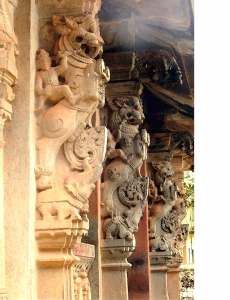Yali, is a heavily used icon in Hindu architecture with a wide variety of physical variations, about 16 they say. Some are depicted as lion faced, with or without trunks like elephants, which are most commonly seen, in comparison to the horse, cat, peacock, goat and even human faced which are very rare. They are depicted both small and large, in comparison to other motifs such as elephants, horses, humans, etc. The belief is that these creatures were very robust ones with supernatural powers and were guardian beasts that adorn most thresholds, wall corners and many pillars and towers of temples, ritual halls, etc.
These creatures are shown in details with feathers or scale like covering, with heavy set of razor sharp teeth, large pointed talons or claws. In some the hind legs are massive compared to the front legs , while others have equally strong looking athletic legs. The eyes are pronounced and generally captivating. Some are depicted humungous compared to a small elephant at its feet, some ridden by humans, some as small as humans as well.
Given that these depictions are present in most of the older temples, one tends to wonder if this was just a fantastic imagination of human mind or could there be some connection to the creatures that roamed around. It is a known fact that many of our civilizations banked on folklore to pass on stories, important values and messages from generation to generation. Could this be one such thing? May be the cave men depicted such creatures in their drawings that the following generations passed on to the next as stories and the creatures that roamed the earth slowly came to life in some creative brains as ‘Yali’ etched and carved on stone?
Pleistocene era or the ice age seems to be the time of major evolution in mankind. It was roughly around this time that the ancestors of elephants and lions came into picture. Horned and hoofed animals are thought to have evolved from the Miocene era. The locally excavated dinosaur bones, like that of Rajasaurus, Rahonavis, Manjungasaurus may be clues of what could have been an inspiration to the depiction of Yali. Cave man paintings have given us a glimpse into the hooved, saber tooths and mammoths. Could it be that there are many more cave paintings that are yet to be found or may be got destroyed by a natural calamity, which could give us answers to this ‘unique’ icon?

Also given the variation of the sizes and the portrayal along with modern animals like elephants and horses, wonder if our ancestors saw a distinct lineage of this enormous animal slowly evolving into smaller species as eons went by? Could it be, that like ‘Annam’ the celestial bird which actually bears a striking resemblance to the modern day swan, there could be modern cousin of ‘Yali’ hidden deep within the sanctuary of the jungles or may be it is just went extinct? Whatever be the case, guess it is a marvelous, mystical creature, Yali ; an amalgamation of animal and bird – may be a dinosaur?

